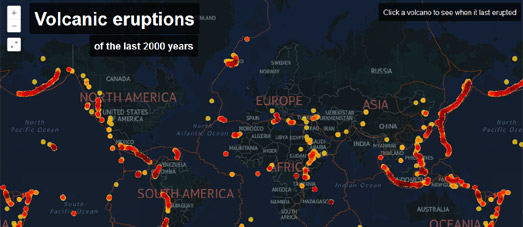
Volcano
A volcano is a mountain with a hole where lava (hot, liquid rock) comes from a magma chamber under the ground.
Most volcanoes have a volcanic crater at the top. When a volcano is active, materials come out of it. The materials include lava, steam, gaseous sulfur compounds, ash and broken rock pieces.
When there is enough pressure, the volcano erupts. Some volcanic eruptions blow off the top of the volcano. The magma comes out, sometimes quickly and sometimes slowly. Some eruptions come out at a side instead of the top.
Volcanoes are found on planets other than Earth. An example is Olympus Mons on Mars.
2
Types Of Volcano
The lava and pyroclastic material (clouds of ash, lava fragments and vapor) that comes out from volcanoes can make many different kinds of land shapes. There are two basic kinds of volcanoes.
Shield volcanoes
These volcanoes are formed by fluid low-silica mafic lava.
Shield volcanoes are built out of layers of lava from continual eruptions (without explosions). Because the lava is so fluid, it spreads out, often over a wide area. Shield volcanoes do not grow to a great height, and the layers of lava spread out to give the volcano gently sloping sides. Shield volcanoes can produce huge areas of basalt, which is usually what lava is when cooled.
3
Stratovolcanoes
The base of the volcano increases in size over successive eruptions where solidified lava spreads out and accumulates. Some of the world’s largest volcanoes are shield volcanoes.
Even though their sides are not very steep, shield volcanoes can be huge.
A stratovolcano, also known as a composite volcano, is a tall, conical volcano. It is built up of many layers of hardened lava, tephra, pumice, and volcanic ash.
Unlike shield volcanoes, stratovolcanoes have a steep profile and periodic eruptions. The lava that flows from stratovolcanoes cools and hardens before spreading far. It is sticky, that is, it has high viscosity. The magma forming this lava is often felsic, with high-to-intermediate levels of silica, and less mafic magma. Big felsic lava flows are uncommon, but have travelled as far as 15 km (9.3 mi).
Two famous stratovolcanoes are Japan’s Mount Fuji, and Vesuvius. Both have big bases and steep sides that get steeper and steeper as it goes near the top. Vesuvius is famous for its destruction of the towns Pompeii and Herculaneum in 79 AD, killing thousands.
Caldera
A caldera is a basin-like feature formed by collapse of land after a volcanic eruption. This happens after a huge stratovolcano blows its top off. The base of the crater then sinks, leaving a caldera where the top of the volcano was before. Krakatoa, best known for its catastrophic eruption in 1883, is much smaller now.
4

5


6
7
Dear Diary,
I want to tell you about the frightening event I had yesterday.
My parents and I wath T.V , suddenly my dog barked lodly.
I didn’t understand what happened we heard people screaming, I looked aut the window and saw a giant lava coming
towards owur building , I understood that it was a volcano that erupted.
My littel sister began to cry,mother started to break dishes with pressure, my father tried to find a solution, and my brother and I were confused and didn’t know what to do.
My mother told us to take very important things and pack them quickly in one of the files.
Where we didn’t see the fire and the girls whose house was burned.All our stuff all the photos and all the memories just burned it was sad. I saw people being woundwd and people crying.
After a few days we left.
And we moved to a newand safe place but I would never forget ny former home.
8
Published: Nov 15, 2017
Latest Revision: Nov 15, 2017
Ourboox Unique Identifier: OB-384898
Copyright © 2017








